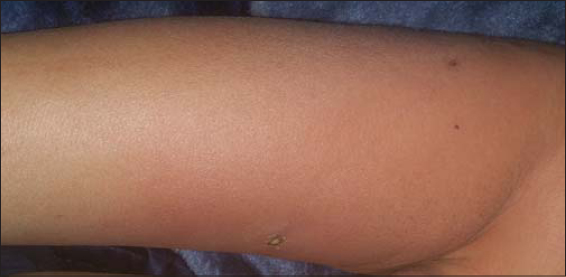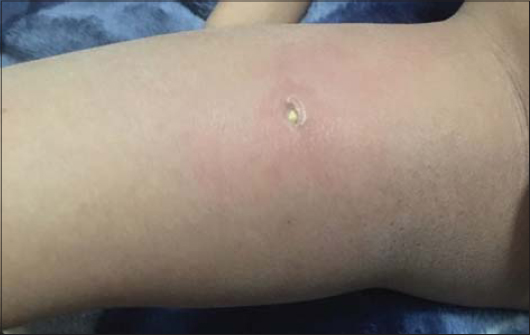A case of varicella complicated with erysipelas
Samia Mrabat , Hanane Baybay, Zakia Douhi, Sara Elloudi, Fatima Zahra Mernissi
, Hanane Baybay, Zakia Douhi, Sara Elloudi, Fatima Zahra Mernissi
Department of Dermatology, Hassan II Hospital University, Fez, Morocco
Corresponding author: Dr. Samia Mrabat
Submission: 26.05.2020; Acceptance: 06.08.2020
DOI: 10.7241/ourd.2020e.96
Cite this article: Mrabat S, Baybay H, Douhi Z, Elloudi S, Mernissi FZ. A case of varicella complicated with erysipelas. Our Dermatol Online. 2020;11(e):e107.1.
Citation tools:
Copyright information
© Our Dermatology Online 2020. No commercial re-use. See rights and permissions. Published by Our Dermatology Online.
Sir,
A four-year old boy presented one week before the consultation with a febrile rush. It had began with small red dots on the torso, then progressed to the face and legs with emergence of small blisters which became umbilicated then evolved to crusts. The patient was given ibuprofen for the fever. 48 hours later, he developped a painful swelling and redness on the right thigh. At the physical examination, he had a 41 degree fever, an exanthema made of lesions at different stages consistent with the diagnosis of varicella, as well as an erythema and oedema of the right thigh, with no necrosis, blisters or purpura (Fig. 1). Blood tests showed an elevated level of C reactive protein at 235, leucocytosis and a normal level of CPK. The diagnosis of erysipelas was then retained and the patient was put under antibiotics with a good outcome (Fig. 2).
Varicella is usually a benign and self-limited disease manifested by mild systemic symptoms, characteristic rash, and low-grade fever. The clinical course is generally mild in healthy children. However, studies have showed that the use of NSAIDs (nonsteroidal anti-inflammatory drugs) was associated with an increased risk of severe skin and soft tissue complications [1]. Therefore fever and pain associated with varicella or herpes zoster should be treated with paracetamol, not a NSAID.
Consent
The examination of the patient was conducted according to the Declaration of Helsinki principles.
The authors certify that they have obtained all appropriate patient consent forms. In the form the patient(s) has/have given his/her/their consent for his/her/their images and other clinical information to be reported in the journal. The patients understand that their names and initials will not be published and due efforts will be made to conceal their identity, but anonymity cannot be guaranteed.
REFERENCES
1. Gershon AA, Breuer J, Cohen JI, Cohrs RJ, Gershon MD, Gilden D, et al. Varicella zoster virus infection. Nat Rev Dis Primers. 2015;1:15016.
Notes
Source of Support: Nil.
Conflict of Interest: None declared.
Request permissions
If you wish to reuse any or all of this article please use the e-mail (brzezoo77@yahoo.com) to contact with publisher.
| Related Articles | Search Authors in |
|
 http://orcid.org/000-0003-3455-3810 http://orcid.org/000-0003-3455-3810 |





Comments are closed.